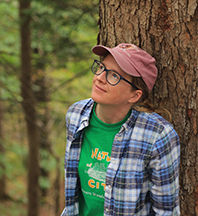Week of August 18, 2024 – August 24, 2024
by Anna Stunkel, Environmental Educator
On the cool summer nights that we’ve been having lately, I’ve found the sounds of nocturnal nature to be very calming. It’s been a great year for katydids and crickets chorusing among the trees and shrubs. If I’m lucky and listen really closely through the window screen, most nights there have been owls calling. Screech owls are especially vocal at this time of year as the young birds venture forth to establish their own territories. The whinny call sounds a lot like a horse, and is used for territorial defense while the softer tremolo helps owls to communicate within their families. One of my favorite sounds is when they combine a whinny with a tremolo. These little owls are known for their adaptability, nesting just about anywhere in the state that has trees.
Sometimes later at night, the deep calls of Great Horned Owls can be heard further in the distance from my window. The female’s call is higher pitched than the male’s, which is noticeable if you’re ever lucky enough to hear them duetting. I haven’t noticed any young calling lately, but years ago I lived right where a pair was nesting. When the babies fledged, they flew all around learning how to hunt and begging for food from their parents. It was such a special experience to have them so nearby and to watch them grow.
In areas with swampy hardwood forest, you might hear Barred Owls at night or even during the day, especially in overcast weather. They are known for their barking call that sounds like, “who cooks for youuuuu? Who cooks for you all?” Their repertoire can also include many kinds of barks and cackles.
With such lovely nighttime weather these days, and as many of us are sleeping with windows open, see if you notice any of these nocturnal songsters. In about a month, on September 14 you can also join us to look and listen for owls during our Night at the Woods program. Happy owling!


